Mechanical Vibrations (ME301)
Course Description: Mechanical systems with single and multiple degrees of freedom; longitudinal, torsional and lateral vibrations; free and forced oscillations; vibration testing, dynamic stability, vibration isolation, design criteria.
Topics:
- SDOF Free Vibration with and without Damping
- Energy Methods
- Equivalent Mass and Stiffness, Log Decrement, Design Considerations
- Stability
- Coulomb Friction
- Forced Vibration with and without Damping
- Base Excitation and Rotating Unbalance
- Measurement Devices
- Introduction to General Forced Response (Impulse Response, Laplace Review, Fourier Series, Frequency Response Functions)
- 2DOF Free and Forced Vibration
- Vibration Suppression (Absorbers, Tuned Mass Dampers)
- Introduction to Modal Analysis
Examples of past student projects:
STRING VIBRATIONS
Jihyun Jung (ME'18), William Lim (ME'18), Hai Shen Rong (ME'18), Abraham Tawil (ME'18)
A string’s vibratory behavior can be characterized as a wave. The vibrations in the string propagate and create standing waves. Depending on the frequency, they can constructively interfere with each other, producing different standing wave patterns corresponding to the different vibrating modes of the string. To learn more about these mode shapes, an experiment with a nylon guitar string was conducted to observe these harmonics. For a fixed, but unknown tension of the string, an electrodynamic exciter was used as the source of vibrations. The frequency of the first mode, or the fundamental frequency was found. Using the theory behind string vibrations, the frequencies for subsequent mode shapes were predicted. A high speed camera was used to record the string vibrating for the first five mode shapes. The experimental frequencies were then verified according to predicted theoretical values, showing errors of less than 2%. This error could have been caused by set-up loosening or larger uncertainty of amplitude. To make a more accurate experiment for the future, an experiment with a known tension is proposed.
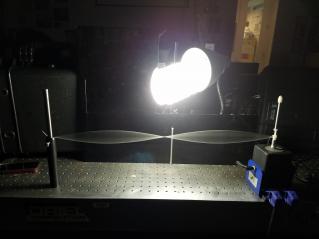
APPLICATION OF MODAL ANALYSIS TO DETERMINE THE SWEET SPOT OF A BASEBALL BAT
Monica Chen (ME'18), Andy Tong (ME'18)
This project determined the sweet spot and sweet zone on a 30-inch aluminum bat. When a baseball makes contact with the bat at the sweet spot, maximum energy is transferred to the ball and zero vibrations are transmitted to the batter’s grip. The sweet spot of a baseball bat varies depending on the length and material of the bat; therefore, the sweet spot of a bat cannot be determined through visual inspection. The optimal method to determine the sweet spot and sweet zone is through vibrational analysis of the bat using impact hammer testing. The sweet spot is defined as the position of the node of the first bending moment and the sweet zone is the region between the nodes of the first and second bending modes. Using the data collected in this experiment, modal analysis can be applied to determine the sweet spot through finding the first and second bending modes of the continuous system. Modal analysis allows the student to observe the dynamic response of a continuous system through a force excitation, in this experiment, the force excitation is from the impact hammer. After finding the bending modes, the experimental data defines the sweet spot of the bat as the distance 23.75 inches away from the knob and the sweet zone as the zone 23.75 to 25.25 inches from the knob.
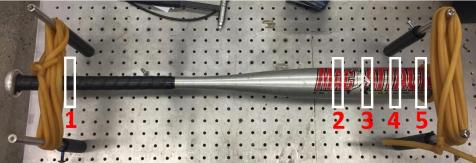
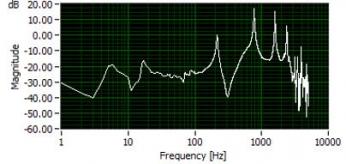
EXPERIMENTAL QUANTIFICATION OF STATIC STABILITY IN A PIPER CHEROKEE AIRCRAFT
Julien Caubel (ME'12) | Daniel Nash (ME '12)
The ability of an airplane under static conditions (i.e. straight, level flight) to reject disturbances with decaying oscillations is known as static stability. The primary objective of this project was to quantify these disturbance rejections in a Piper Cherokee aircraft by studying the dynamics of a naturally occurring decaying oscillation known as the phugoid mode. A test apparatus was constructed to measure the pitch angle, pitch and roll velocity, and vertical acceleration of the Piper aircraft during specified testing maneuvers. Using the test rig, the response of the airplane to impulse and step disturbances to the yoke was recorded and subsequently processed in real time with MATLAB. In addition to the impulse response, aircraft motion was captured during straight, level flight, take off, and landing. Though the plane was observed and analytically confirmed to never enter the phugoid mode, data gathered under contrived aircraft motion verifies that the rig functions properly and that the aircraft response can be modeled as a damped, second-order system.
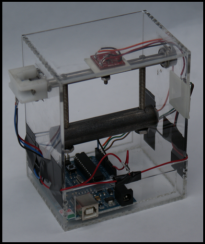
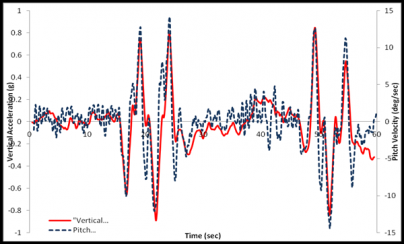
A STUDY OF UNDESIRED VIBRATIONS ON AN ATOMIC FORCE MICROSCOPE
Beatriz Ponce (ME'11) | Eglind Myftiu (ME'11) | Saman Farid (ME'11) | Jillian Schinski (ME'11)
The purpose of an Atomic Force Microscope (AFM) is to use responses from its scanning cantilever to create an accurate image of the surface under study. This project aims to investigate the vibrational effects from the environment causing inaccurate AFM scans, specifically the effect of seismic structure-borne vibrations and sound-induced vibrations due to an HVAC system. To determine the environmental effects of undesired vibrations on the AFM’s cantilever beam, the excited frequencies of the cantilever beam and potential environmental vibration sources were measured and analyzed. The data was transformed into the frequency domain using MATLAB by performing Fast Fourier Transforms. Analysis of the accelerometer and microphone data in the frequency domain reveals peaks in the vibration and acoustic responses around 200 Hz suggesting acoustic vibrations have a significant impact on the AFM.
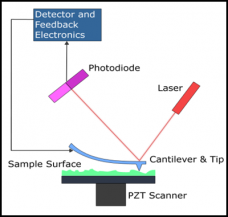
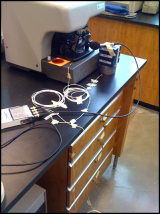
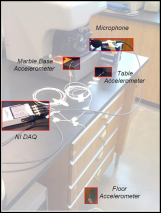
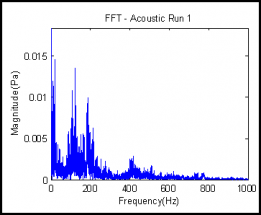
MODELING OF ACCUMULATOR FOR POGO SUPPRESSION
Alex Bronfman (ME'09) | Rishabh Chandra (ME '10) | Caroline Lama (ME '10) | Sherry Liang (ME '10)
For decades, aerospace companies had to deal with the pogo phenomenon that occurs when pressure and flow in liquid propellant rockets interact with the launch vehicle structure. An experiment was done to model one of the ways aerospace companies used to mitigate these self- induced oscillations. The method of using an accumulator to dampen out the vibrations in the propellant feedline was common. A model was made to include a scaled-down feedline with accumulators attached, and manometers to measure the pressure before and after the accumulator. Pressure vibrations of the air were induced with a solenoid valve to imitate propellant vibrations. Pressure leaving the accumulator was dampened; this dampening effect was increased for increasing driving frequency.
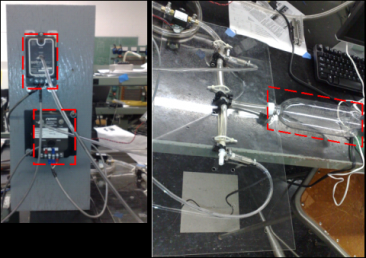
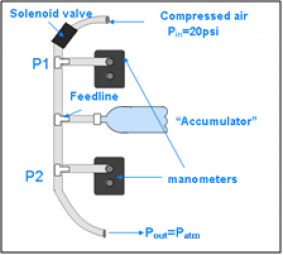
INVESTIGATION OF THE EFFECT OF A MASS DAMPER ON THE FORCED RESPONSE OF A STRUCTURAL MODEL
Cheng Pan (ME '10) | Sam Glauber (ME '10) | Mark McKinnon (ME '10) | Antonia Zaferiou (ME '10)
This experiment examined the effect of a mass damper on the forced response of a structural model. A structural scale model of a three-story building was constructed and excited harmonically by an electrodynamic shaker. The response of the model was measured using accelerometers attached to each floor. The building was excited from 1 to 20 Hertz and displacement data was analyzed with and without a tuned mass damper.

Updated 9/20/2012

